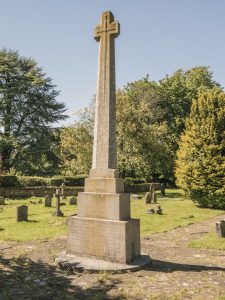St. James’ Church Cross was designed by Edwin Lutyens and was given a Grade II listing on 13th July 1974. In 2015, it was decided that all Lutyens memorials would be given listed status.
In 2014, Museum Chairman Nigel Arch presented a talk on the Evolution of the War Memorial, which included the history of the Abinger Cross.
“A particularly interesting memorial is to be found in the churchyard of Abinger Common. It was commissioned by Margaret Lewin in memory of her son Charles Mclean Lewin, of the 4th Hussars and records the names of the fallen from both the First and Second World Wars. In form it is a cross, set on a stepped plinth, the body of the cross bearing a “Crusader’s Sword”- because the soldiers were seen as modern crusaders, fighting against evil. It was designed by Lutyens, who had worked on several houses in the area. The architect had originally opposed the idea of the cross as a motif in war memorials, on the basis that it would exclude non Christians. Clearly he reconciled himself to the idea to produce this fine memorial.”
Read the rest of the talk here
The Lewin family were well known in the local area.
One very well known woman in the mid-19th century, Harriet Grote (1792-1878) was born a Lewin, who lived at The Ridgeway in Shere.
Harriet Grote was called The Empress by family. Married George Grote 1794-1871. he a radical politician a historian, educated her but a willing pupil as little educated by governesses. His father a banker. Described by Cobden as ‘a remarkable woman, desperately blue of stocking’. Eloped and married in 1820 as her father would not a set wedding date. Met radical and intellectual friends, including Bentham and Mill. Became a political radical. He beame an MP and leader of radical faction advocating democratizing constitutional reform especially extended suffrage. Known as the Grote conclave. The Whig government had only a slim majority in the 1830s and they set themselves up to side with the opposition in the hope of extracting concessions in return for not bringing the government down. She was more bold than her husband, described as ‘more of a man, but not a better man than her husband.’ Tactics largely failed. They were described as ‘Mrs Grote’s little party’ and she as ‘queen of the radicals’. Cobden said that ‘had she been a man, she would have been leader of a party.’ She called the 1930s ‘a pregnant decade if ever there was one.’
Brought Jenny Lind to England and patronised women artists. She assumed equality with men. One man wrote that he was going to see ‘the two Mr Grotes’ and another that she was like ‘a regular politician in breeches.’
The organised feminist movement was emerging in the mid 19th century and she lamented being born a woman. She supported the married woman’s property act and extension of the vote to women and regretted when the campaign for women’s vote got under way in the 1860s that she was not 30 years younger and might have been able to lead it.
Her later years she devoted to writing.
Her nephew (son of her brother, Frederick), was Thomas Herbert Lewin who lived at Parkhurst in Abinger in late 19th/early 20th century. He bought Parkhurst in 1884 (b. 1839 and lived there until death in 1916). His wife Margaret is buried at Abinger church. She was very involved with Bertha Broadwood’s Holt-Ockley nurses locally.
According to the reminiscences of Jocelyn Bray Col Lewin of Parkhurst was involved in local cricket and the family gave ‘proper’ dances at Parkhurst.
Colonel Lewin published a book called The Lewin Letters – a selection of the correspondence of an English family 1756-1885 in 1909.


